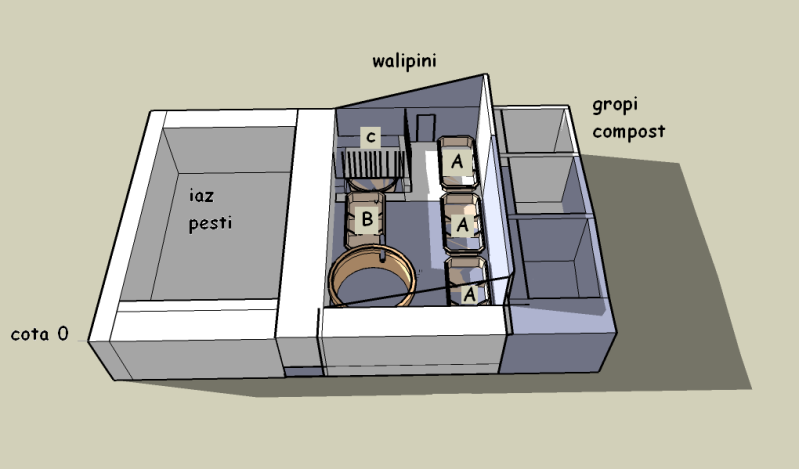
1. Iazul - purtator de crap, folosit pentru aquaponica pe timpul verii si protector la iernat. O adancime de 2 m in punctul cel mai de jos. Este realizat cu membrana EPDM. La 0,5 m sub adancimea maxima a iazului ingrop cel putin 50 m teava PE , cu amandoua capetele in walipini. Scop- racirea apei din sistemul aquaponic din walipini pe perioada verii. Nu am nevoie de temperaturi excesive ... visul meu ar fi pastrav curcubeu
2. Walipini - la 2 m sub cota 0, nezidit. Pentru a proteja walipini, la o distanta de constructie se va realiza un drenaj . Pietris pe podea, iar intr-unul din colturi se va realiza o scurgere in caz de inundare. In walipini, pe langa sistemul aquaponic (B), am prevazut un numar de wicking-beds(A) . De asemenea,o voliera pentru gaini(C). Prezenta vietatilor, intr-o densitate acceptabila, cred eu ca ar contribui la o crestere a temperaturii interioare pe timpul iernii. Iluminat artificial dupa nevoie. O atentie deosebita acordata ventilatiei!
3. Gropile de compost- folosite ca surse de caldura pentru walipini pe timpul iernii. In walipini, rezervoare de tabla pline cu apa ce se recircula prin tevi de PE ingropate in compost. Inainte de a ajunge in rezervoarele radiante, PE trece prin wicking beds, eventual pe langa bazinul aquaponic cu pesti, pentru un surplus de temperatura. Sunt prevazute 3 gropi, pornite in momente diferite, pentru a realiza o continuitate pe timpul iernii ( o groapa va furniza caldura 6-8 saptamani)
Pe forumul unde am supus dezbaterii aceasta idee am primit critici legate de apropierea iazului si de folosirea gainilor in sera. Intre timp am renuntat la iaz (consider ca nu am nevoie de volume mari de apa din motive de eficienta) , am schimbat walipini pe sera clasica (volum mult prea mare de sapatura) si ma gandeam serios sa renunt si la ouatoarele din sera.
Zilele trecute insa am gasit la diyaquaponics asta:
"The idea of using compost for GH heating was well tested back in the 1970's and 80's, and has been used in Europe for decades. The Mother Earth News, Rhodale, and others, ran various types of projects with compost heating, but probably the most successful and extensive GH testing was done by a group calling itself the New Alchemy Institute in Woods Hole Massachusetts. They were able to maintain constant winter growing temps with the use of enclosed and insulated compost chambers along the north wall of their greenhouses as the only source of heat aside from solar gain. Greenhouse air was forced into the center of each of 10 compost bins through perforated pipes, thus avoiding the need for any manual or mechanical mixing. Exhaust from the top of the compost bins was drawn off and forced through perforated pipes laid beneath the compost-rich soil of the grow beds. Soil bacteria then converted ammonia, produced by reaction of nitrogen with water vapor during decomposition, into the usual nitrites and nitrates. Compost heat was thus transfered directly into the soil, maintaining bed temperatures in the 70's F on the coldest winter days, while filtered CO2 was passed up through the soil and made directly available to the plants.
Interestingly, these folks were also early pioneers of greenhouse aquaponics.
Aside from generating heat, compost produces lots of CO2 which increases plant productivity
significantly (25% or more.) As I recall, it was found that when unventilated, as is often the case during cold cloudy weather, a lush greenhouse can consume virtually all the available CO2 in an hour or two, thus bringing photosynthesis to a complete halt until more is made available. Many commercial greenhouses heat with natural gas to maintain high CO2 levels and increase crop yields, and some even use compressed CO2 in the summer months. AP and hydroponic systems are especially prone to CO2 loss since there is little or no decomposing organic material in the otherwise soil-less grow beds.
Aside from compost, experiments were also done using chickens housed at one end of a hoop greenhouse and separated from the food growing area by a wall that incorporated straw and sawdust filters to get rid of "chicken dust" which would otherwise settle on the plants. A solar powered forced air system circulated the filtered air from one side to the other. The seasonally enclosed chickens added both heat and CO2 to the system, and their waste was incorporated back into the compost system to apparently accelerate the thermal output. The chickens and eggs also provided an additional food stream, along with the produce and fish.
Manure from cows, rabbits, and goats was also composted using red worms. While not generating much heat, vermacomposting does boost the CO2 levels, and the worms provided a supplemental food source for the fish."
Am sapat netul pentru New Alchemy Institute si am gasit buletine editate de ei, unele extrem de interesante pentru subiectul nostru - aici
Si intrebarile revin - gaini in sera??? compost??? walipini?